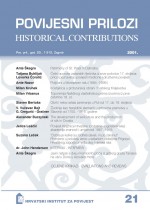Kostajnica u protuturskoj obrani Hrvatskoga Kraljevstva
Kostajnica in the Anti-Turkish defense of the Croatian Kingdom
Author(s): Milan KruhekSubject(s): History
Published by: Hrvatski institut za povijest
Summary/Abstract: After the fall of the Bosnian Kingdom in 1463 and the heavy defeat of the Croatian nobility at the Field of Krbava in 1493, the conquering Ottoman armies started to threat immediately the safety and existence of the lands of the Croatian Kingdom. The medieval development of Croatia was violently interrupted in all fields. The Croatian struggle for historical survival of the country and the nation lasted for more than two centuries, during the 16th and 17th century. In this struggle, the individual interests of the nobility and the common state policy of the Croatian Kingdom led by the Croatian Parliament permanently clashed The old feudal fortresses of the Croatian nobility had the most important role in the anti-Ottoman defense, especially in the southern highlands. The fortified feudal towns (castrums and citadels), the medieval centers of the feudal administration and judiciary, were turned into the fortified bastions to stop the Ottoman penetrations, plundering and destruction of the land. That was also the destiny of the feudal fortress Kostajnica on Una. The ownership of Kostajnica, the strong stone fortress built on a small island on the river of Una in front of the settlement bearing the same name on the left coast on the foothills of Djed Hill, changed many hands in the medieval period. In the 16th century, in the period of frequent Turkish raids across the river of Una, Kostajnica was feudal property of a very powerful feudal family of Zrinski, who also owned many other important fortified towns and settlements: Novi, Krupa and Liπnica on the river of Una, and Zrin, Prevrπac, Gvozdanski, Komogovina and Gorička in the area between Una and Zrinska gora. Kostajnica was the most important fortress on the rivers of Una between the royal fortified town of Bihać and the confluence of the rivers Una and Sava near Jasenovac. This is the reason why its owners, princes Zrinski did everything they could have to reinforce the fortress and to make it capable to resist the Turkish attacks. They kept their military crew in Kostajnica fortress as long as they could pay for it from the feudal revenues from their land and from the assistance they received from the king and other anti-Turkish European allies. Of course, this assistance was never sufficient, so Zrinski family tried to save their property in the Una basin by signing a separate peace agreement with the Turks. However, when they turned the policy of good neighborhood into the policy of active fight against the Turkish conquest, incited by the royal promise of the needed assistance, the Turkish armies almost completely destroyed their property in the Una basin in frequent attacks in the 1630s. In such a situation the Zrinski family was forced to cede their fortresses on the river of Una, including Kostajnica, to the defense of the royal army.
Journal: Povijesni prilozi
- Issue Year: 2001
- Issue No: 21
- Page Range: 71-97
- Page Count: 27
- Language: Croatian

